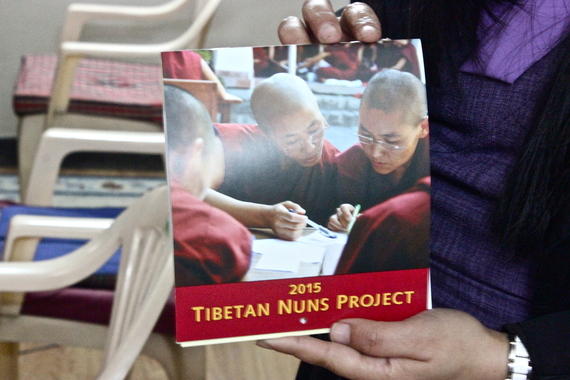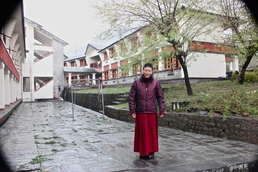"If it brings peace to the country, even a nun can become a king."
-- Tibetan proverb
Delek is 45 years old. She has an open face and defined laugh lines. When we enter the media lab she places three chairs side-by-side-- one for me, one for Tsering, our translator, and one for herself. We sit together in a moderately-sized room with a sixteen-inch Macbook and a television. "Is this where you make your videos?" I ask. Delek nods. Sitting there, it is easy to forget that the larger context is Dolma Ling, a nunnery in the Kangra Valley, just outside of Dharamsala, India.
Delek's current home, Dolma Ling Nunnery and Institute, was founded by Rinchen Khando Choegyal, the sister-in-law of His Holiness the 14th Dalai Lama. It officially opened in 2005-- the first institute dedicated solely to higher Buddhist education for Tibetan nuns. While primarily a site of higher Buddhist learning, it is also part of a larger project, to empower women and preserve Tibetan culture. The nuns learn mathematics, science, Tibetan, and English language. They receive training in traditional handicrafts and ritual arts, including the creation of sand mandalas and butter sculptures. "I think it is very important that they receive a modern education, but only once they have mastered Tibetan language and traditional practices," Rinchen Khando says clearly. "I always joke with the nuns that this infrastructure is not meant for picknicking. It is meant for studying."
Rinchen Khando in her office at Dolma Ling nunnery.
When I enter Rinchen Khando's office she sits poised on a sofa by the window. In many ways, she epitomizes grace. Articulate, soft-spoken, and strong she is also the founder of the Tibetan Women's Association, and has dedicated most of her life to helping her fellow countrywomen. When I ask her why she started the nuns project she smiles, "We started the Tibetan Nuns Project after the riots in Tibet in 1987. There was an influx of nuns to India, and they had nowhere to go. Many of them had been beaten so badly, their kidneys and backs were damaged. After walking over the mountains, their eyes, toes, and hands were frostbitten. So you can imagine what it was like." Rinchen Khando looks at me, "I founded the Tibetan Nuns Project out of the Tibetan Women's Association. I asked the Tibetan Women's Association branches to help provide healthcare and accommodation. That same year I wrote to friends all over the world. It took some time, but I got more encouragement. Then I looked into setting up two nunneries."
Today, the Tibetan Nuns Project (TNP) includes eight nunneries across northern India. It supports over 700 nuns, providing them with accommodation, food, and medical care. Each nun has a personal sponsor who donates thirty dollars per month to cover her basic expenses, simultaneously sustaining the project and ensuring its commitment to quality education. Rinchen Khando's current vision to construct an on-site learning center for lay Tibetan women and non-Tibetan women from around the world, highlights her commitment to connecting the East and the West through scholarship bridging traditional and modern values. "Our nuns are very digitally-minded. They have computer lessons, and we now have two to three nuns recording the debates and reporting everything about the nunnery. Still, I feel that they need to go slowly. Technology is a wonderful tool, but the users have to be very mature, and know what they are using it for."
Delek standing outside of Dolma Ling nunnery.
Fast-forward through a lunch of home-made momos, or Tibetan dumplings, and I sit in the media lab with Delek, the nunnery's main media curator. As she retells her journey to India I am more impressed by her humility than anything else. She is quick to downplay her walk to freedom. Delek arrived with around 25 other nuns, carrying little more than a change of clothes and a sack of tsampa, or roasted barley flour. "When you look down from the Hill Station to the plains and you see the lights twinkling. That was the same experience we had when we reached Nepal." She continues, "We were quite lucky when we crossed because no one died, and only one monk wounded his head. We stayed at the reception center in Nepal for four months. They were then sent to India on a bus. When we arrived we hoped we could join Gaden Monastery, a monastery near the reception center in McLeod Ganj, but there was no space. Rinchen Khando and the TWA took care of us."
Delek has been studying at Dolma Ling since the late 1980s. She recently finished a 15-year course in Tibetan Buddhist philosophy, but her real passion is media. She learned video editing, Adobe Photoshop, and Indesign from an Austrian volunteer, who spent some time at the nunnery mentoring her and a few of the other nuns. Today, most of the nunnery's videos and books are designed and produced by Delek, and she has created more than twenty book covers. "Many Tibetan youth have a good education out in society, but only a limited number of people have this knowledge. So, video-making is a good skill to have," Delek explains.
After the interview Delek and I walk into the courtyard for a short photo-shoot. I can't help asking her about the future: "What do you hope to do with all of your skills?" Delek smiles, "Well, one day I hope to return to Tibet to teach the people in my village about what I've learnt. I also dream of working in media, of creating cartoons themed around peace and good morals. Today, cartoons just show shooting and violence. I would like to create peaceful cartoons where the characters wear traditional Tibetan costumes."
I hear Rinchen Khando's vision in Delek's words. Before the close of our interview, Rinchen Khando asked me to think about the concept of women's empowerment: "What does it really mean?" Through simultaneously preserving Tibet's wisdom tradition and encouraging women to embrace and thrive through knowledge acquisition she is not only empowering Tibetan women, she is giving them the tools to empower themselves. Delek's work and outlook speak to the power of that lens.


